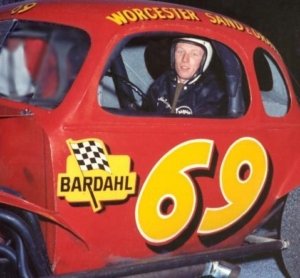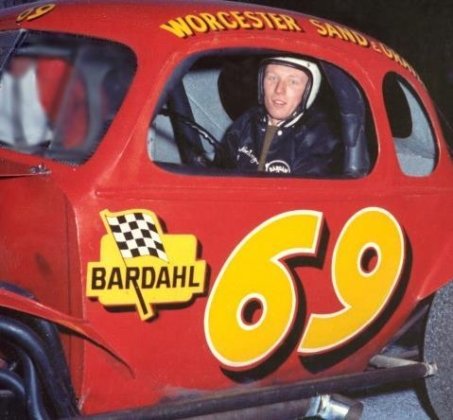
While Pete Hamilton was more than a one-hit wonder, his NASCAR career was relatively short compared to most series competitors. Hamilton’s racing career took off when he moved South at the end of the 1967 racing season. Prior to that his career had been confined to the New England area.
 The Massachusetts native started his racing career in 1962 racing in the Street Stock division at the now defunct Norwood Arena. He moved up and in 1965 he was crowned Champion of the Thompson World Series Twin 50s. The pinnacle of his New England racing career came in 1967 when he won the NASCAR Late Model Sportsman National Championship driving the Worcester Sand & Gravel #69.
The Massachusetts native started his racing career in 1962 racing in the Street Stock division at the now defunct Norwood Arena. He moved up and in 1965 he was crowned Champion of the Thompson World Series Twin 50s. The pinnacle of his New England racing career came in 1967 when he won the NASCAR Late Model Sportsman National Championship driving the Worcester Sand & Gravel #69.
Once down in NASCAR country Hamilton continued his rise. In 1968 he competed in 15 NASCAR Grand National (Cup) events and was named series Rookie of the Year. He drove for a couple of different owners that year, including for A.J. King in his #1 Dodge.
In 1969, Hamilton opened the season competing in the Daytona 500 in King’s Dodge, but his main focus was running in the NASCAR Grand American Division, a series made up of pony cars, Camaros, Mustangs, etc. Hamilton had a very successful season winning 12 of the 26 series events and the series championship.

In December 1969, Petty Enterprises, long associated with Plymouth, returned to the fold after a one-year hiatus. The following month Petty Enterprises announced that Pete Hamilton, a 26-year- old native of Dedham, Massachusetts would be the driver of the second car in the Lee Petty Racing team.
“We plan to field two cars in each of the major races this year,” Lee Petty said. “Richard (Petty) will run for the Grand National title again and will make every race on the circuit. Pete will be spared the short track grind and can concentrate on the big money events. We think he will develop into a big winner.”

On February 19, 1970, Hamilton made his debate driving for Petty Enterprises at Daytona in a 125-mile qualifier in which he started sixth and finished fifth. This earned him the ninth starting position in the Daytona 500.
In the Daytona 500 Hamilton was in the mix throughout a good part of the race, leading laps 63 through 65 again on lap 139 as in true Daytona fashion the lead changes were many. Then on lap 187, Dick Brooks blew a motor bringing out the yellow flag.
Hamilton, who had just led unofficially four laps prior, but had not shown a lot of muscle, pitted and got four new tires from his Maurice Petty led crew. David Pearson, who had officially led all but one lap since lap 144 (the last 44 laps) pitted and took two right side tires only.

On the lap 192 restart, Hamilton grabbed the lead with Pearson in hot pursuit. Pearson mounted a final charge with two laps to go but Pearson’s car wobbled, and Hamilton went on to score the biggest upset in the then 12-year history of the Daytona 500.
“I was aware of the sling shot here.” said Hamilton after the race. “But I felt I could stay in front of David (Pearson) if I could get ahead of him. I thought my car was stronger than his after I took fresh tires, We both got crossed up when he tried to slingshot me. Both of our cars were out of shape.”
Later Hamilton commented, “I’m a young driver with a lot to learn.” He said. “Winning one race doesn’t prove you know it all.”

Hamilton’s next race was on March 18 at the Carolina 500 in Rockingham where he qualified seventh and finished fifth. Then it was the Atlanta 500 on March 29 where he started fifth led laps 62 & 63 and finished fifth.
Then it was the Alabama 500 at Talladega on April 12. Qualifying sixth, Hamilton laid back early, finally led a lap at 140. The main competition was Buddy Baker in the Cotton Owens Dodge who led 14 times for 105 laps.
Baker made his final pit stop and was coming after Hamilton when on lap 175 Baker blew a tire and spun out with rubber chunks cutting his oil lines and starting his car on fire. Hamilton led the last 18 laps of the race and took the checkers 44 seconds ahead of runner up Bobby Isaac in the K&K Dodge.

“You can’t beat a Petty Plymouth or a Petty plan.” said Hamilton. “Our plan was to set back early in the race and get an idea what tire problems there might be. Once we found out tires weren’t a major problem, we upped our pace.”
On May 9, Hamilton qualified 4th at Darlington and led one lap before engine trouble sidelined him after 150 laps relegating him to a 19th place finish. Next came the grueling World 600 at Charlotte on May 24 where he qualified fifth and settled for an eighth-place finish.
On June 7 at Michigan in a controversial finish, Hamilton scored his first Cup pole, led several times and was always in the thick of things. Then things got confusing, Cale Yarborough at one time two laps down, passed Hamilton late in the race to win by 3 tenths of a second with Hamilton finishing second.
 However, there was a question whether Yarborough was on the lead lap. Richard Petty claimed,” The cards say Cale lapped Peter under caution with the pace car lapping Peter. That’s impossible.”
However, there was a question whether Yarborough was on the lead lap. Richard Petty claimed,” The cards say Cale lapped Peter under caution with the pace car lapping Peter. That’s impossible.”
The Firecracker 400 at Daytona saw fourth and lead twice for a total of ten laps before ignition problems sidelined him after 46 laps and finished 30th. Then it was Atlanta where he started tenth and finished sixth. At the Yankee 400 in Michigan, he started 12th and finished sixth.
On August 23 it was the Talladega 500, the fourth and final Super Speedway race of the season, Hamilton did not disappoint. After qualifying fourth, he dominated the event leading 153 of 188 laps averaging 158.517 mph.
The fast 500-mile stock car race in history. “Some guys could run fast as I could with fresh rubber,” said Hamilton. “But their tires wore down a little and I could run deeper into the corner. I knew I had them covered.”
At the Southern 500 at Darlington, he started sixth and posted a third-place finish. Back at Charlotte after qualifying fifth, Hamilton was strong all day leading five different times for 108 laps before crashing out after 226 laps and finishing 24th. At Rockingham, Hamilton started tenth but a lap crash and he finished 15th.

Ironically, his last race of the season was a .395-mile short track at Hampton, Virginia in Dick Brooks Plymouth. He did quite well after qualifying 17th, he finished third. He ran 16 Cup races in 1970, had three Super Speedway wins and finished 21st in points.
In 1971, Hamilton moved to Cotton Owens #6 Plymouth and won immediately. In the first 125-mile qualifier he started sixth, led three different times, including the last lap when he passed A.J. Foyt who lifted for a wrecking car. It was Hamilton’s last Cup win.
Driving almost exclusively for Owens, Hamilton ran 22 Cup races and finished in the top five an impressive 11 times. But no more wins.

After 1971, Hamilton ran just five more Cup races, 3 in 1972 and 2 in 1973. He retired from full-time NASCAR racing because of complications from a neck injury in a 1969 Grand American race. He continued to compete in short track racing and won the 1974 Snowball Derby.
Along the way he helped Larry Rathgeb develop their “Kit Car”, a weld-it yourself Volare or Aspen Late Model Stock Car that any driver could order from Plymouth and Dodge dealers.
He moved to Norcross, Georgia and worked as a car builder and mentor to many drivers in the 1980’s Southern Dirt tracks, helping launch successful careers for a number of drivers.

Peter Hamilton was inducted into the New England Auto Racers Hall of Fame in 1998, its inaugural year and into the Georgia Racing Hall of Fame in 2012. Hamilton passed away on March 21, 2017, at the age of 74 due to complications of a stroke.
While he was successful in several forms of motorsports, he will always be remembered for being behind the wheel of the Powder Blue #40 Plymouth of Petty Enterprises winning in 1970 on NASCAR’s Super Speedways.









